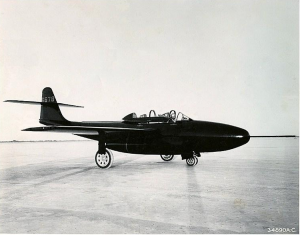22 February 1950 – “The Northrop F-89 Scorpion was an American all-weather, twin-engined interceptor aircraft built during the 1950s, the first jet-powered aircraft designed for that role from the outset to enter service. Though its straight wings limited its performance, it was among the first United States Air Force (USAF) jet fighters equipped with guided missiles and notably the first combat aircraft armed with air-to-air nuclear weapons (the unguided Genie rocket).”(1)
 “The first (s/n 46-678) of the two XF-89 prototypes (redesignated from XP-89 in 1948) was flown by Fred Bretcher on August 16, 1948, from Edwards AFB, California. For the first 32 flights, it had conventional wing ailerons but on February 1, 1949, a new series of trials began with Northrop ‘decelerons’ which were to be a standard feature of all production Scorpions. The ‘deceleron’ was a split surface which operated in one piece as an aileron but which could be opened out to serve also as a dive brake.”(2)
“The first (s/n 46-678) of the two XF-89 prototypes (redesignated from XP-89 in 1948) was flown by Fred Bretcher on August 16, 1948, from Edwards AFB, California. For the first 32 flights, it had conventional wing ailerons but on February 1, 1949, a new series of trials began with Northrop ‘decelerons’ which were to be a standard feature of all production Scorpions. The ‘deceleron’ was a split surface which operated in one piece as an aileron but which could be opened out to serve also as a dive brake.”(2)
The XF-89 was flown to March AFB to participate in the RKO movie Jet Pilot in February 1950. “After making a low pass at high speed for USAF officials at Hawthorne Airport (Northrop Field), it crashed 5 miles (8 km) from the Northrop factory on Rosecrans Avenue at Flournoy Road, Manhattan Beach, California, killing the flight engineer, Arthur Turton. The pilot Charles Tucker parachuted to safety.
Flutter had “developed in the elevator and the subsequent vibrations caused the entire tail to break off. Construction of the production models was suspended until the reasons for the accident were discovered.” (1) Engineering and wind-tunnel tests revealed that the geometry of the rear fuselage and the engine exhaust created flutter-inducing turbulence that was aggravated by the high-frequency acoustic energy from the exhaust. Fixes for the problem involved the addition of a “jet wake fairing” at the bottom rear of the fuselage between the engines, external (“ice tong”) mass balances for the elevator, pending the design of internal mass balances,[16] and the addition of exhaust deflectors to the fuselage to reduce the turbulence and the consequent flutter. (2)
The XF-89 was lost on its 102nd flight on February 22, 1950, after making a low pass at high speed for USAF officials at Hawthorne Airport (Northrop Field). It crashed 5 miles (8 km) from the Northrop factory on Rosecrans Avenue at Flournoy Road, Manhattan Beach, California. The pilot, Charles Tucker, parachuted to safety, but the flight engineer, Arthur Turton, was killed. The cause of the accident was the high-frequency, low amplitude aeroelastic flutter of both vertical and horizontal stabilizers. (2)
